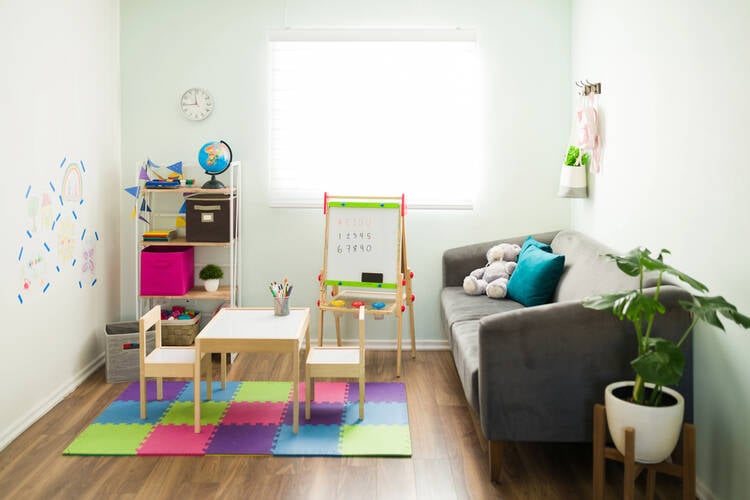
One of the best ways to attract and retain clients in your ABA therapy business is by creating the right therapy room décor.
A well-designed space can enhance comfort, reduce distractions, and promote a positive atmosphere for both clients and therapists.
The right décor not only supports the therapy process but also helps children feel safe, motivated, and engaged during sessions.
If you own an ABA therapy business and want to stand out, investing in the right room décor is essential.
From calming color schemes to organized learning stations, each element plays a role in creating an inviting and functional space.
In this article, we will share some of the best ABA therapy room décor ideas to inspire you and help transform your space into a warm, productive environment.
Best ABA Therapy Room Décor Ideas
-
Use Calming Colors
Choose soft, calming colors like light blue, pastel green, or beige for your walls and furniture.
These tones help reduce anxiety and overstimulation, making it easier for children to focus on therapy activities.
Avoid overly bright or neon shades that might distract or cause sensory discomfort.
You can combine a neutral base with a few colorful accents, such as wall art or cushions, to create visual interest without overwhelming the senses.
The right color palette can set the tone for a peaceful and structured environment, encouraging better participation and engagement during therapy sessions.
-
Create Defined Learning Zones
Divide your ABA therapy room into distinct sections for different activities, such as a reading nook, a table for structured tasks, a sensory play area, and a quiet corner for breaks.
This organization helps children understand expectations for each area and makes transitions smoother.
Use rugs, room dividers, or shelves to mark boundaries without making the space feel closed off. Visual cues like signs or labels can reinforce understanding.
Having clear zones supports better behavioral outcomes by promoting structure, minimizing confusion, and helping children develop a sense of order in their learning environment.
-
Incorporate Sensory-Friendly Elements
Since many ABA clients have sensory processing needs, incorporating sensory-friendly items is essential.
Include soft textures, weighted blankets, tactile toys, and fidget tools to help children regulate their emotions.
Sensory walls with different materials, small ball pits, or sensory bins can also provide valuable input.
Be mindful to balance sensory stimulation and avoid overcrowding the space with too many items that might overwhelm a child.
Sensory-friendly décor ensures children have tools to manage their emotions, stay engaged, and participate fully in therapy activities without becoming overstimulated.
-
Display Positive Visual Supports
Use laminated posters, colorful icons, and large, easy-to-read fonts to display daily routines or expected behaviors. Place them at eye level for children to reference easily.
This not only aids communication but also helps children feel secure knowing what to expect next. Positive reinforcement charts and goal trackers can motivate progress.
By making these supports visually appealing, you integrate function into décor while reinforcing essential ABA principles in an engaging and accessible way.
-
Add Comfortable Seating Options
Comfortable seating encourages focus and relaxation during therapy sessions.
Include a mix of seating types, such as small chairs for table work, bean bags for reading, and floor cushions for group activities. Make sure seating is appropriately sized for children and easy to clean.
Flexible seating arrangements also give children some control over their environment, which can be motivating and reduce behavioral issues. Pair seating with small, cozy rugs or mats to make the space inviting.
-
Incorporate Natural Lighting
Natural light can greatly influence mood and attention span. If possible, arrange your therapy room to allow sunlight to brighten the space. Use sheer curtains to soften glare while keeping the room bright.
If natural light is limited, choose full-spectrum light bulbs to mimic daylight. Avoid harsh fluorescent lights that can cause discomfort or headaches.
Natural light not only improves the overall feel of the room but also promotes alertness and positivity, making children more receptive to learning and interaction during therapy sessions.
-
Use Educational Wall Art
Select wall art that is both decorative and educational, such as alphabet charts, number posters, emotion charts, and nature scenes.
These visuals can act as prompts for spontaneous teaching moments while making the room visually stimulating intentionally.
Use bright but balanced colors to maintain interest without overwhelming the senses.
Rotating wall art periodically can keep the environment fresh and engaging for returning clients.
-
Keep Décor Organized and Clutter-Free
Clutter can be visually overwhelming and distracting for children. Use storage bins, shelves, and labeled containers to keep toys, materials, and supplies organized and easily accessible.
Transparent bins can help children quickly identify what they need while promoting independence.
A tidy, well-organized therapy space communicates professionalism and creates a sense of calm, which can help children focus better.
Incorporating organization into the décor, such as color-coded bins or matching storage furniture, also enhances the overall aesthetic while maintaining function.
-
Include a Quiet Corner
A quiet corner provides a safe space for children to take breaks when they feel overwhelmed.
Decorate it with calming elements like soft cushions, dim lighting, and neutral colors.
Add calming tools such as stress balls, noise-canceling headphones, or simple sensory toys. The corner should be comfortable yet minimal to prevent overstimulation.
Having a designated calming space encourages self-regulation, reduces meltdowns, and gives children control over managing their emotions during therapy.
-
Use Interactive Bulletin Boards
An interactive bulletin board can be a dynamic and educational focal point in the therapy room.
Use it to display the “theme of the week,” therapy goals, or student achievements.
Incorporate velcro-backed pieces, flaps, or pockets for hands-on activities that align with therapy objectives. Change the content regularly to maintain interest and engagement.
Interactive boards not only make the décor functional but also provide opportunities for skill-building in language, matching, and problem-solving, while celebrating progress in a visually appealing way.
-
Integrate Plants or Nature Elements
Bringing nature into the therapy space can create a calming, refreshing environment.
Use child-safe plants, such as spider plants or pothos, to improve air quality and add a touch of green.
Nature-themed décor, like a mural of trees or a wall decal of a sunny meadow, can also have a soothing effect.
If live plants are not feasible, consider realistic artificial plants. Exposure to natural elements is linked to reduced stress, improved focus, and better mood.
-
Choose Easy-to-Clean Materials
When selecting furniture and décor, prioritize durability and easy maintenance.
You may want to go for wipeable surfaces, stain-resistant fabrics, and washable rugs to maintain hygiene in a high-use environment.
Brightly colored but easy-to-clean materials can keep the room looking vibrant while ensuring it remains safe and sanitary.
This is especially important for therapy spaces, where multiple children use the same materials and surfaces daily.
-
Incorporate Mirrors for Feedback and Interaction
Mirrors can be a powerful tool in ABA therapy, especially for self-awareness and social skills training.
Placing a child-safe mirror on one wall allows children to observe their own expressions and body language during activities.
This can be used for teaching emotions, imitation skills, or speech therapy. Mirrors also help make the room feel larger and brighter.
Integrating mirrors into the décor makes the space functional while offering unique learning opportunities in a visually engaging way.
-
Rotate Seasonal and Theme-Based Décor
Changing the décor periodically keeps the therapy environment fresh and exciting for returning clients.
Incorporate seasonal elements like snowflakes in winter, flowers in spring, or pumpkins in fall.
You can also align décor with therapy themes, such as “animals,” “community helpers,” or “space.” Keep changes subtle so they don’t overwhelm children with sensitivities.
-
Personalize with Client Artwork
Displaying client artwork on the walls creates a sense of pride and ownership for the children.
Rotate pieces regularly so each child gets the opportunity to showcase their work. Use colorful frames or a dedicated “art wall” to make the display inviting.
This not only decorates the space but also serves as a motivator for children to participate in creative activities.
Personalizing the environment in this way fosters a welcoming atmosphere and strengthens the connection between clients and the therapy space.
